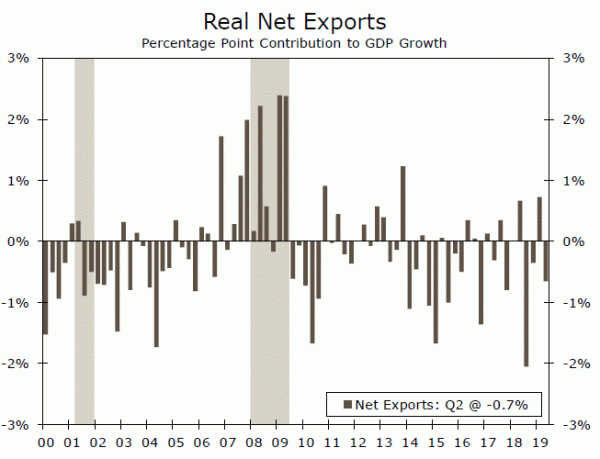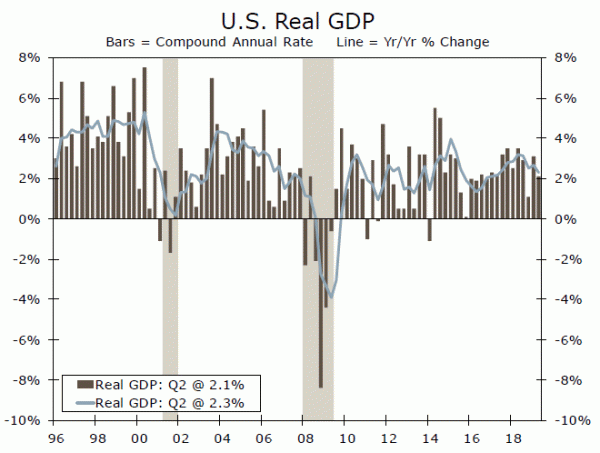Net exports and inventories weighed on the overall rate of real GDP growth in Q2. Although the outturn was a bit stronger than expectations, the FOMC likely will still cut rates 25 bps on July 31.
Strong Consumption, but Weak Net Exports and Inventories
U.S. real GDP grew at an annualized rate of 2.1% in Q2-2019 (top chart), which was a bit stronger than the 1.8% growth rate that the consensus forecast had anticipated. The year-over-year growth rate slowed to 2.3% in the second quarter from the 2.7% clip that was registered in Q1.
Overall GDP growth in the second quarter was driven largely by real personal consumption expenditures (PCE), which shot up 4.3%. Recent monthly data on retail spending have been strong so the robust PCE growth rate in Q2 came as little surprise. Specifically, real spending on durable goods soared nearly 13%, the strongest sequential growth rate in five years, while expenditures on non-durable goods climbed 6.0%. Real consumer spending on services grew at a solid growth rate of 2.5%. In short, the PCE data show that the American consumer is alive and well.
Government spending, which grew 5.0% in Q2, was another notable area of strength. That said, the overall growth rate was flattered by the 15.9% jump in non-defense federal spending, which reflects a bounce-back from the government shutdown in December and January. Overall government spending should grow more slowly in coming quarters.
On the other hand, there were some notable areas of weakness. For starters, the GDP data show that the nation’s housing market remains largely stuck in the doldrums as real residential construction spending edged down 1.5%, the sixth consecutive quarter in which this spending component has declined. Real exports fell 5.2%, which reflects slower growth in the rest of the world as well as trade war effects. Although real imports were essentially flat on the quarter, real net exports sliced 0.7 percentage points from the overall GDP growth rate (middle chart). As we previewed in a recent report, less inventory accumulation in the second quarter reduced overall GDP growth by another 0.9 percentage points (bottom chart).
No Implications for the July 31 FOMC Meeting
In our view, today’s GDP print has very few implications for the FOMC meeting on July 31. Although the outturn was slightly stronger than expected, we still look for the FOMC to cut its target range for the fed funds rate 25 bps. Looking forward, we expect that real GDP will continue to grow between 2% and 2.5% in coming quarters. That said, inflation continues to run below the Fed’s target of 2%, and the FOMC seems to be concerned about some of the uncertainties related to trade and other geopolitical factors that cloud the economic outlook. Many members of the FOMC seem to be taking the view that it should probably take out a few “insurance” rate cuts at this time, especially in an environment in which high inflation simply is not a problem.
















